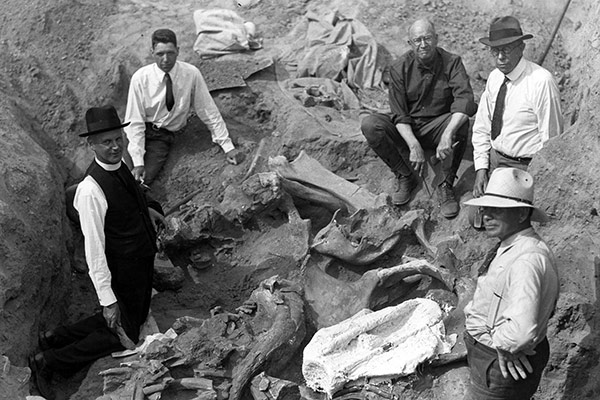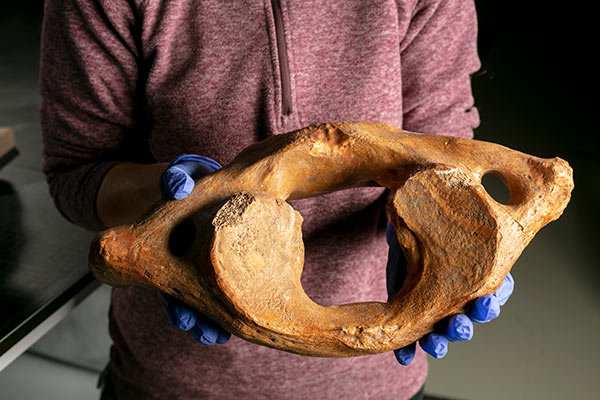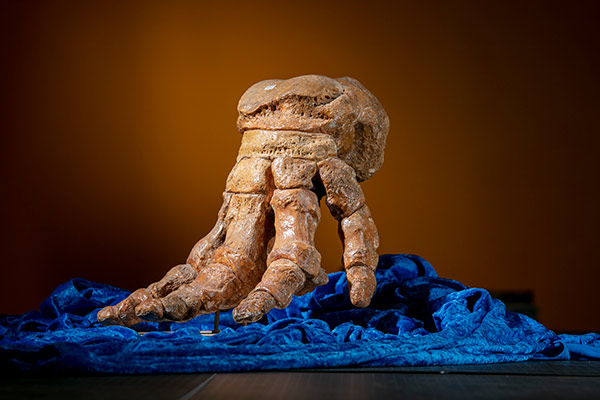Regis Professor Had a Few Bones to Pick
About the only label Regis’ Brown and Gold newspaper scribes didn’t apply to the mammoth assembled from the Ice Age bones a professor and his students unearthed in 1932 was the one it deserved: One of the most significant archaeologic finds in Colorado, one that provided early evidence of a culture that was long believed to be the continent’s first human inhabitants.

Ninety years ago this fall, Regis Prof. Rev. Conrad Bilgery, S.J., and a group of students whose names have been lost to time, began an excavation that ultimately pulled from the high plains of Weld County along the South Platte River bones from five adult female and eight young mammoths, and two spear points.
By 1935, the bones had been assembled into two complete mammoth representations. The first was traded to the Carnegie Museum of Natural History in Pittsburgh, in exchange for “a dinosaur long coveted” by what is now the Denver Museum of Nature & Science (DMNS), the Brown and Gold reported. The second was unveiled at the Denver museum to great local fanfare. The city’s newspapers ran large photos of the specimen; the Rocky Mountain News’ version featured three awestruck children staring up at it, mouths agape.
At the time, few complete mammoth skeletons were on display anywhere; the Brown and Gold cited a curator at New York’s American Museum of Natural History saying none were to be found in this country as of 1929.
Brown and Gold writers went on to breathlessly declare that the display “stands as a lasting memorial to the Regis men who discovered and assisted in exhuming the remains of this prehistoric monster.”
That memorial might never have been created if it weren’t for a few days of relentless spring rain.
By the 1930s, the spear points and the bones of the animals they killed had lain beneath layers of soil for thousands of years. Trains periodically roared over them, crossing the plains of what was by then Weld County in Northern Colorado.
One April morning in 1932, a railroad foreman named Frank Garner went to work in the now-demolished Dent Depot, which sat southeast of the town of Milliken. In those pre-internet, pre-television days, Garner probably had plenty of time to kill between trains and plenty of nothing to look at. But that morning, after days of rain eroded soil, Garner spotted something odd poking out of a nearby gully.
Garner investigated and surmised that the bones belonged to some extremely large animal that no longer roamed around Colorado. And he took home with him a spear tip of what would become known as Clovis Culture.
Garner told a lot of people about what he found out there along that lonely stretch of track. Some accounts record that one of the people he told was his son, who happened to be a Regis College student. Others say that Garner reported the find to the depot master, Michael Ryan, and it was Ryan’s son who was the Regis student.
Whoever the young scholar was, he alerted his professor, Rev. Conrad Bilgery.
Bilgery was born in Switzerland around 1881. In 1902, he immigrated to the United States, and by 1928, was a Jesuit priest and a mathematics professor at Regis. According to 1930 U.S. Census records, Bilgery lived on campus that year with 29 other priests and Regis faculty members and seven men described as “servants.”
Regis documents don’t make clear whether Bilgery taught anthropology or paleontology, or had formal training in those fields.
However, several accounts of the Dent site excavations refer to him as a geology professor.
In 1906, the United States Congress passed the Antiquities Act, which protected archaeological sites on federal land from excavation. But Dent was private property, so Bilgery only needed permission from the railroad and nearby farmers to start digging.
As enthusiastically reported in the Brown and Gold, Bilgery and his students began their excavation in September 1932 and continued it through November, “when the approach of winter halted them.”
The following summer, Bilgery enlisted the help of Jesse Figgins, and the dig resumed. Figgins, the first professional director of the Colorado Natural History Museum, as the Denver Museum of Nature & Science was known then, had worked at the National Museum of Natural History in Washington and was a veteran of several archaeological expeditions. Figgins recently has been exposed as one of Denver’s many prominent Ku Klux Klan members during the 1920s, a stain that tarnishes his achievement here: Guiding the Denver museum to the forefront of a revolutionary change in archaeology, which was recognizing that human beings coexisted with huge and extinct Pleistocene- epoch animals, like mammoths.
In 1932, when Bilgery rounded up some students and headed to Weld County to dig up mammoth bones, it was only seven years since the Scopes “Monkey” Trial riveted and divided the nation. Two of the country’s greatest orators, attorney Clarence Darrow and perennial presidential candidate William Jennings Bryan squared off in a Tennessee courtroom where high school teacher John Scopes was tried for teaching evolution. Scopes was convicted and fined $100 — and evolution became one of the most incendiary topics of the time.
 But Bilgery made his thoughts on evolution, and the Earth’s age clear. He frequently spoke on the topic on campus, vehemently refuting what he considered a misguided theory, one he believed that both faith and scientific evidence debunked.
But Bilgery made his thoughts on evolution, and the Earth’s age clear. He frequently spoke on the topic on campus, vehemently refuting what he considered a misguided theory, one he believed that both faith and scientific evidence debunked.
At the time, whether dinosaurs and humans co-existed also was a hot topic of debate, said Bob Brunswig, Ph.D., emeritus professor and research fellow in anthropology at the University of Northern Colorado. Brunswig has studied the site and written extensively about the significance of the Dent findings.
It was also a time when scientists lacked the technology to resolve the debate. It wasn’t until the 1960s that radiocarbon dating became available, Brunswig said.
Thanks to improved dating technology, the consensus now is that the Dent site artifacts date back 11,000 years, Brunswig said.
Excavation tools in the 1930s weren’t much better than technology for dating artifacts, and as a result Bilgery, and even the more experienced Figgins, did significant damage at the site in the course of recovering the bones and spears, Brunswig said.
From his own research, Brunswig has concluded the excavated bones represent “two separate killing events,” an indication that whatever was at location 10,000 or so years ago, it repeatedly drew mammoths. And those early humans knew they were likely to find a few meals there.
 While the new mammoth that debuted at the Denver museum in 1935 was big news locally, outside Colorado, the find and its significance barely registered. “It doesn’t get the recognition it deserved,” said Steve Nash, Ph.D., director of anthropology and the Denver Museum of Nature & Science. “The findings were never published, or at least not published properly” in the scientific journals that mattered at the time.
While the new mammoth that debuted at the Denver museum in 1935 was big news locally, outside Colorado, the find and its significance barely registered. “It doesn’t get the recognition it deserved,” said Steve Nash, Ph.D., director of anthropology and the Denver Museum of Nature & Science. “The findings were never published, or at least not published properly” in the scientific journals that mattered at the time.
A year after the Regis group did its work in the Weld County soil, another archaeological team in a little town in New Mexico uncovered a set of similar artifacts. That archaeological team was savvy enough to trumpet their findings in the right places. As a result, the people long regarded as the first human inhabitants who created a widespread culture in the Americas, are known worldwide as Clovis Culture. Although later discoveries cast doubt on Clovis Culture’s claim to be the first North American humans, the culture’s fame lives on.
In a fair world, “It should be called Dent Culture,” Nash said. “But there’s no way to change that now. ‘Clovis’ is entrenched.”
That so many of the artifacts wound up in far-flung museums may be a shame, but according to Nash, it’s not a surprise. “People traded collections like baseball cards back in the day,” he said.
These days, what is left of the Dent discovery at the DMNS is stored – carefully – in drawers and on shelves in a section of the museum that is off-limits to the public. The “antediluvian monster” no longer inspires awed stares at DMNS. The display was removed in 2000, Nash said, to make way for one devoted to space exploration.
Bilgery died in 1945, and was buried in the Regis cemetery then located on campus. And in the 1950s, Frank Garner gave that spear point he took home to the Denver museum.
What Garner, Bilgery, Figgins and those Regis students found discovered buried near that depot lives on, in exhibits and drawers and closets in far-flung museums across the country.
The find “provided insight into early humans and how they hunted,” Brunswig said.
He believes that what has been recovered so far may be but a small percentage of what lies beneath the Dent site. “The better part of that bone bed may be under the railroad tracks,” he said. The tracks belong to Burlington Northern, though, and the railroad, which refused a photographer’s request to visit the site, isn’t likely to allow a mass excavation there.
So, whatever secrets the bones, spears or other artifacts that lie beneath may hold about life in prehistoric Colorado will remain hidden for the foreseeable future.